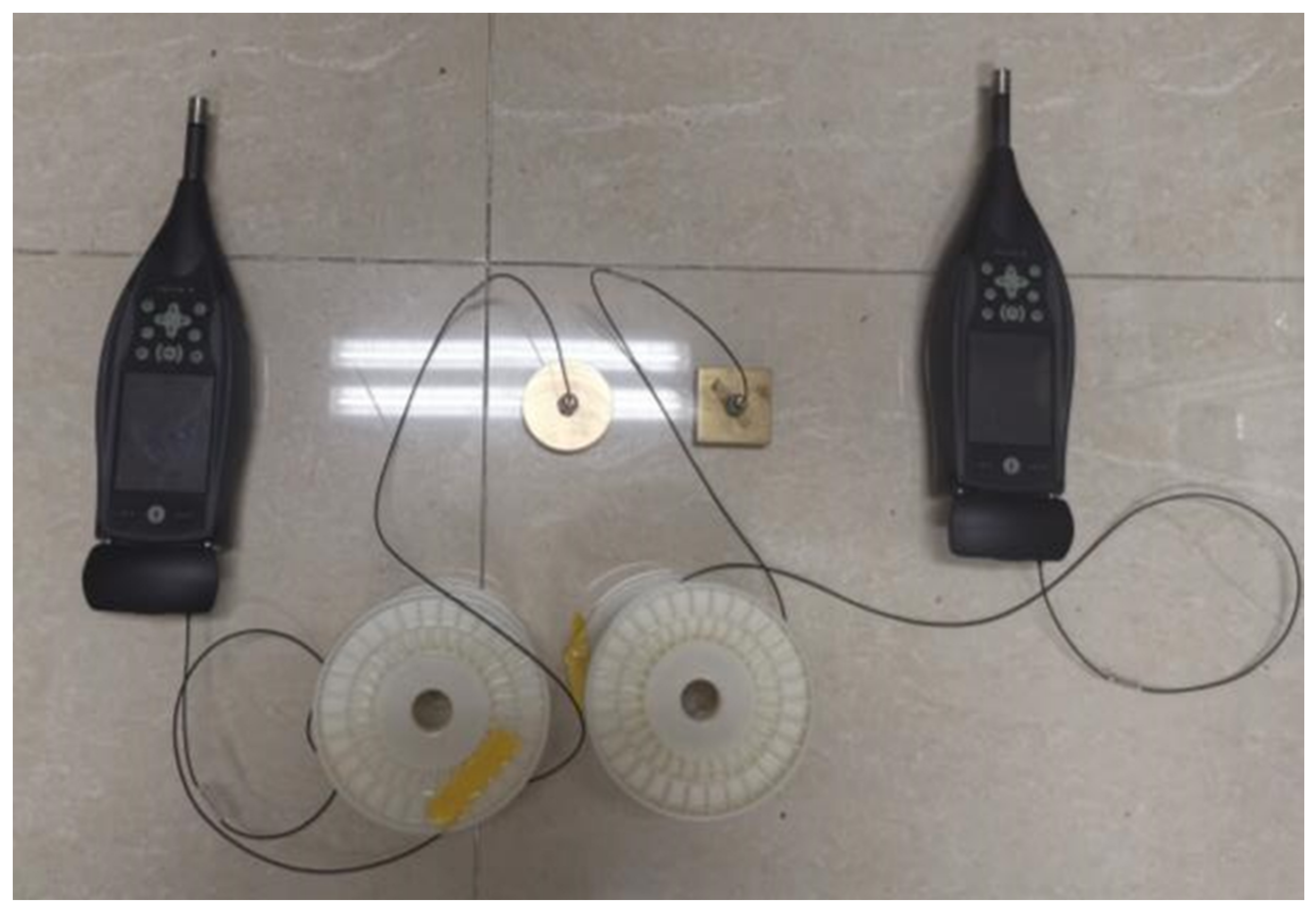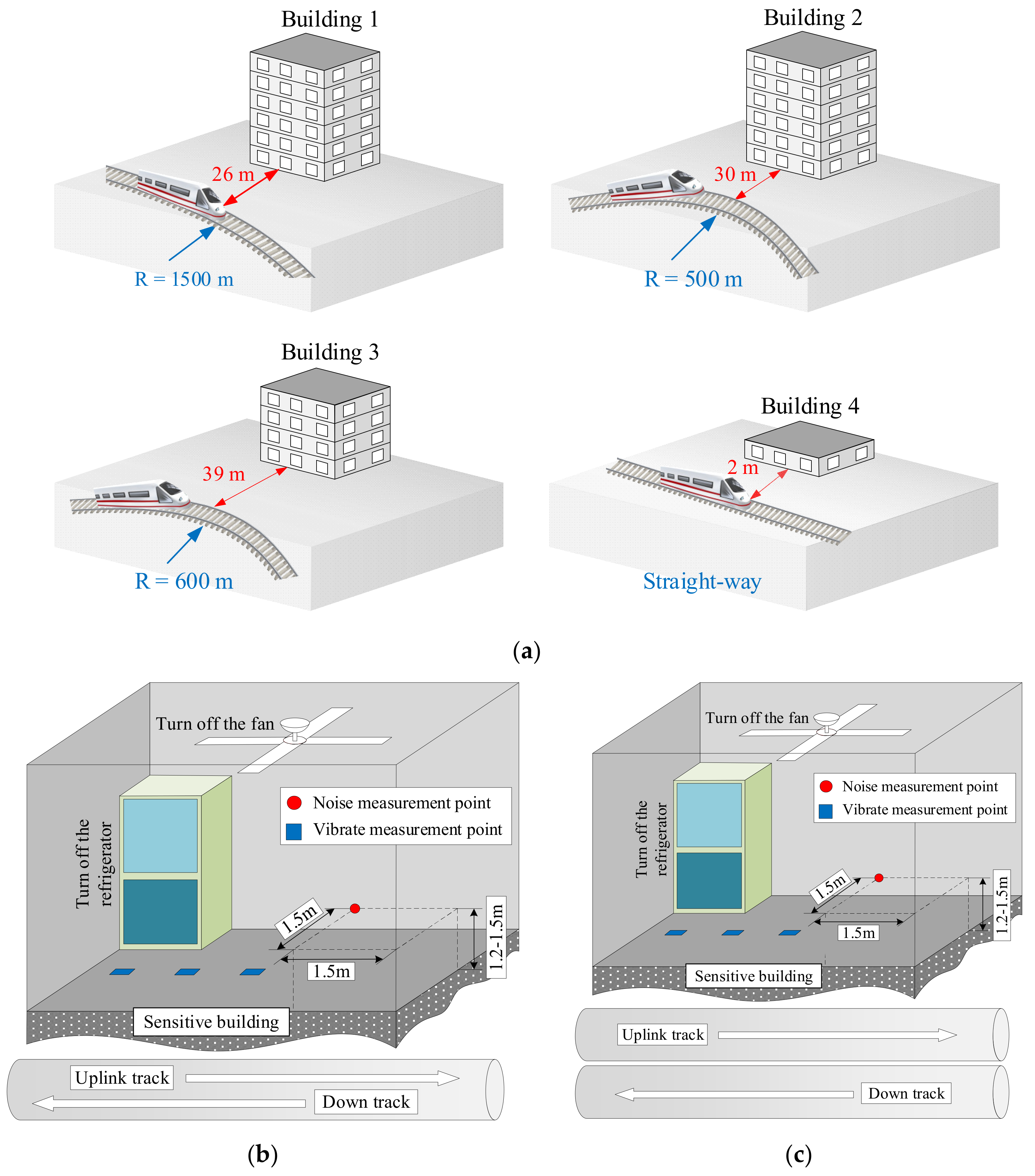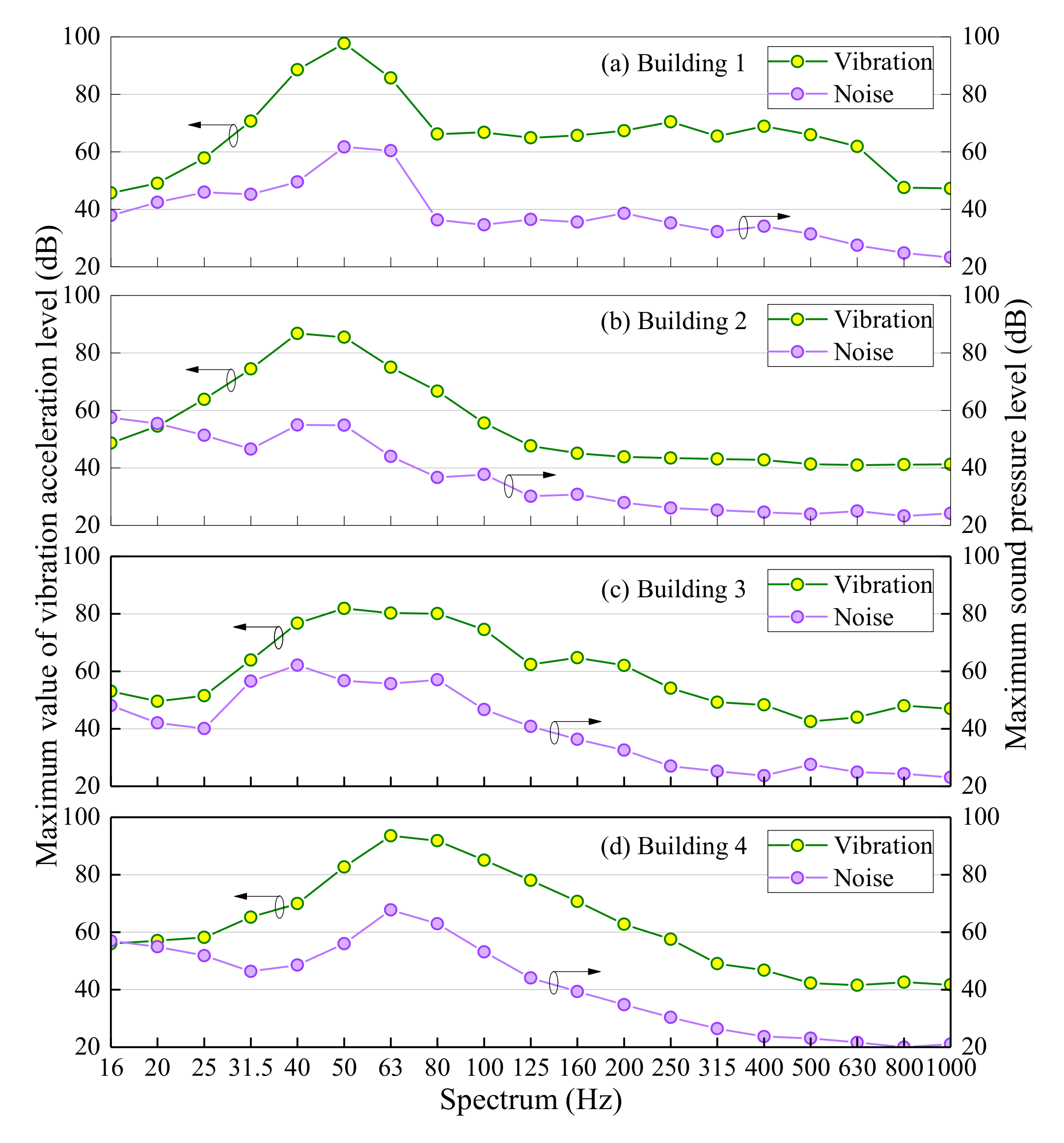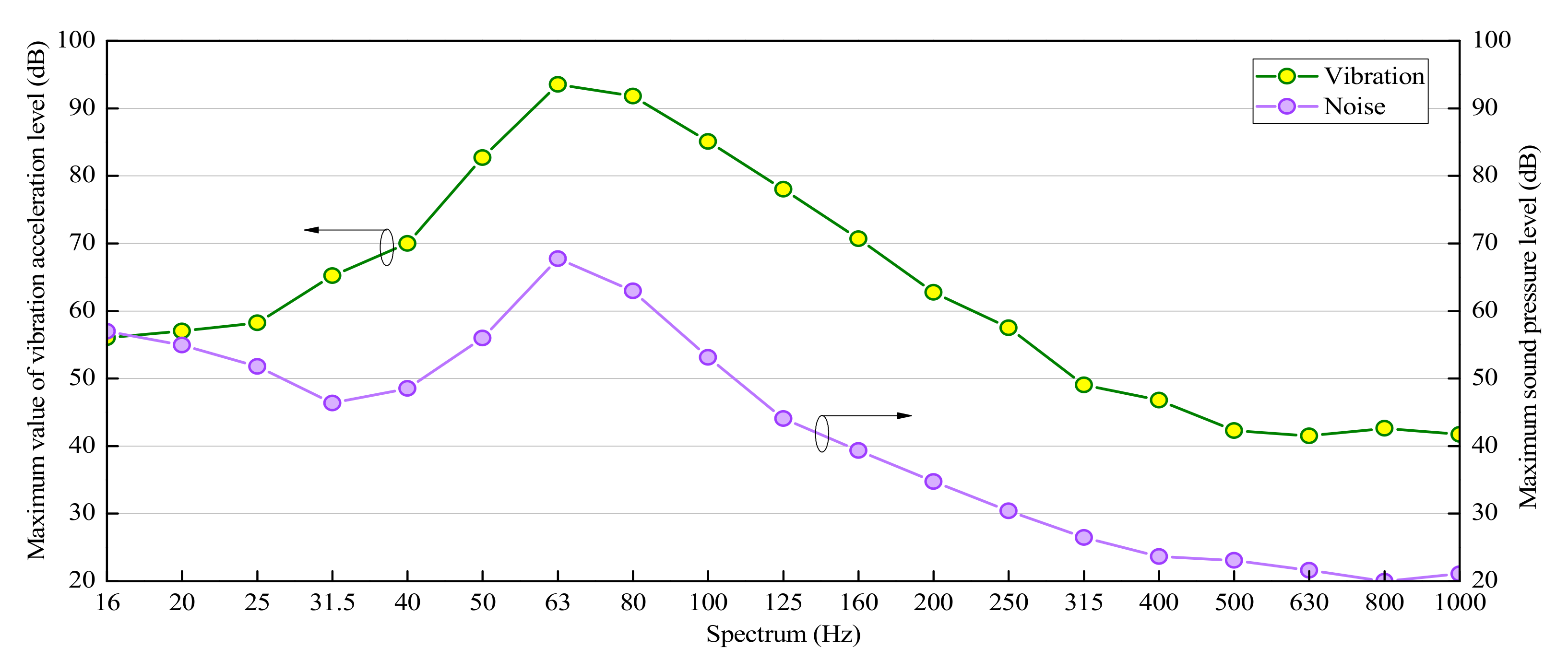Study of Noise and Vibration Impacts to Buildings Due to Urban Rail Transit and Mitigation Measures
Abstract
:1. Introduction
2. Methodology
2.1. Test Setup
2.2. Key Assumptions
- Meteorological conditions, imperceptible noise in the room and sources of vibration have no effect on the measurement results.
- For the track lines of the same type and the same material, slight differences in the material batches can be ignored in the measurement results.
- The acoustic characteristics of sound waves will not change significantly during the propagation process.
2.3. Data Processing Method
3. Results
3.1. Indoor Vibration and Noise Spectrum Analysis
3.2. Analysis of Noise Reduction Measures
3.2.1. Noise Reduction Measure 1: Wheel and Rail Polishing
3.2.2. Noise Reduction Measure 2: Subway Speed Reduction
3.3. Overall Indoor Vibration and Noise Levels
3.3.1. Analysis of Vibration and Noise Reduction Measurement Results under Different Standards
3.3.2. Evaluation and Analysis According to Standards
4. Discussion
5. Conclusions
- Wheel-rail grinding and train speed reduction could reduce the indoor noise levels of buildings by up to 11 dB. After wheel and rail grinding, the vibration level could be reduced by at least 5 dB when the frequency spectrum was 50 Hz. After the subway speed was reduced, the vibration level of the noise could be reduced by 10 dB.
- The noise reduction effect depended on the decay of the magnitude of vibration transmitted into the room and the degree of frequency decay in the resonance of the building. Based on the actual measurement data in this study, after wheel and rail grinding, the noise level could be reduced by more than 8 dB when the frequency spectrum of the noise was 50 Hz. At the same time, after the speed of the subway was reduced, the noise level could be reduced by more than 10 dB.
- The indoor vibration of the measured city and the peak frequency of the noise were near 40 Hz, 50 Hz and 63 Hz. The vibration and noise data of each measured point were highly correlated. As the frequency increased, the secondary radiation noise-decay trend and vibration caused by the subway vibration remained the same.
- After grinding, it was found that the vibration peak points of other non-main peak frequency bands could occur due to the physical contact surface changes between the wheels and rails. The vibration and noise attenuation energy after speed reduction were mainly concentrated near 50 Hz. Through speed reduction, the noise and vibration in the buildings along the subway operation section could be significantly reduced.
- Based on evaluations against the most stringent limits in the ISO 717-1 and GB 50118 standards, the findings of this study suggest that the national current standards need to be tightened to ensure compliance by URT developers and operators.
Author Contributions
Funding
Data Availability Statement
Acknowledgments
Conflicts of Interest
References
- Swinburn, T.K.; Hammer, M.S.; Neitzel, R.L. Valuing Quiet: An Economic Assessment of U.S. Environmental Noise as a Cardiovascular Health Hazard. Am. J. Prev. Med. 2015, 49, 345–353. [Google Scholar] [CrossRef] [PubMed] [Green Version]
- Liu, J.; Lian, S. Vibration and noise of the urban rail transit. J. Traffic Transp. Eng. 2002, 2, 29–33. [Google Scholar]
- He, P.; Cui, Z. Dynamic response of a thawing soil around the tunnel under the vibration load of subway. Environ. Earth Sci. 2015, 73, 2473–2482. [Google Scholar] [CrossRef]
- Ding, Z.; Li, D. Dynamic response analysis on vibration of ground and track system induced by metro operation. Eng. Comput. 2019, 36, 958–970. [Google Scholar] [CrossRef]
- Lowtan, D.M. Rail System in Malaysia. Mass. Inst. Technol. 2004, 1–16. Available online: https://www.mendeley.com/catalogue/bd53967e-6dda-3134-a56d-69e23c1f1ae0/ (accessed on 6 January 2022).
- Chen, C.H.; Peng, L.Y. The Laws and Measurements Analysis about Urban Rail Transit Noise and Vibration Reduction. Appl. Mech. Mater. 2014, 548, 1839–1843. [Google Scholar] [CrossRef]
- Xia, H.; Cao, Y. Problem of railway traffic induced vibrations of environments. J. Railw. Sci. Eng. 2004, 1, 44–51. [Google Scholar]
- Lyu, J. A Prediction Model of Urban Rail Transit Noise. In Proceedings of the 2020 International Conference on Communications, Information System and Computer Engineering (CISCE), Kuala Lumpur, Malaysia, 3–5 July 2020; pp. 137–142. [Google Scholar]
- He, W.; He, K.; Zou, C.; Yu, Y. Experimental noise and vibration characteristics of elevated urban rail transit considering the effect of track structures and noise barriers. Environ. Sci. Pollut. Res. 2021, 28, 45903–45919. [Google Scholar] [CrossRef] [PubMed]
- Zhang, P.; Hao, Y.; Zhang, L.; Sun, H.; Zhang, J.; Xu, Y. Study on the Applicable Standard of Secondary Radiation Noise Caused by Metro Train Vibration. Environ. Monit. China 2020, 36, 154–159. [Google Scholar]
- Yao, J.; Xia, H.; Zhang, N. Numerical Analysis on Building and Soil Vibrations Induced by Moving Trains Considering Dynamic Soil-structure Interaction. J. China Railw. Soc. 2014, 36, 93–98. [Google Scholar]
- Yang, J.; Zhu, S.; Zhai, W.; Kouroussis, G.; Wang, Y.; Wang, K.; Lan, K.; Xu, F. Prediction and mitigation of train-induced vibrations of large-scale building constructed on subway tunnel. Sci. Total Environ. 2019, 668, 485–499. [Google Scholar] [CrossRef]
- Liu, W.; Ma, M.; Wang, W. Prediction Method for Subway Train-Induced Environmental Vibration Responses. China Railw. Sci. 2013, 34, 110–117. [Google Scholar]
- Xie, W.; Zhao, N.; He, W.; Peng, Y. Analysis on vibration serviceability of over-track buildings. China Civil Eng. J. 2013, 46, 90–96. [Google Scholar]
- Liang, R.; Liu, W.; Ma, M.; Liu, W. An efficient model for predicting the train-induced ground-borne vibration and uncertainty quantification based on Bayesian neural network. J. Sound Vib. 2021, 495, 115908. [Google Scholar] [CrossRef]
- Yang, Y.; Weining, L.; Weifeng, L. Propagation Law of Ground Vibration in the Curve Section of Metro Based on In-Situ Measurement. China Railw. Sci. 2012, 33, 133–138. [Google Scholar]
- Vogiatzis, K.; Kouroussis, G. Airborne and Ground-Borne Noise and Vibration from Urban Rail Transit Systems. In Urban Transport Systems; IntechOpen: London, UK, 2017; pp. 61–87. [Google Scholar] [CrossRef] [Green Version]
- Mouzakis, C.; Vogiatzis, K.; Zafiropoulou, V. Assessing subway network ground borne noise and vibration using transfer function from tunnel wall to soil surface measured by muck train operation. Sci. Total Environ. 2018, 650, 2888–2896. [Google Scholar] [CrossRef] [PubMed]
- Hammad, A.; Wu, P.; Hammad, M.; Haddad, A.; Wang, X. Mathematical Optimisation of Rail Station Location and Route Design in Urban Regions through Minimising Noise Pollution. In Proceedings of the 35th International Symposium on Automation and Robotics in Construction, Waterloo, ON, Canada, 20–25 July 2018; Volume 35, pp. 1–6. Available online: http://www.iaarc.org/publications/fulltext/ISARC2018-Paper244.pdf (accessed on 6 January 2022).
- Lopes, P.; Costa, P.A.; Ferraz, M.; Calçada, R.; Cardoso, A.S. Numerical modeling of vibrations induced by railway traffic in tunnels: From the source to the nearby buildings. Soil Dyn. Earthq. Eng. 2014, 61, 269–285. [Google Scholar] [CrossRef]
- Andrew, P.; Peter, P.; Lars, V.A. Evaluating annoyance mitigation in the screening of train-induced noise and ground vibrations using a single-leaf traffic barrier. Sci. Total Environ. 2021, 790, 147877. [Google Scholar]
- He, C.; Zhou, S.; Di, H.; Zhang, X. An efficient prediction model for vibrations induced by underground railway traffic and experimental validation. Transp. Geotech. 2021, 31, 100646. [Google Scholar] [CrossRef]
- Houston, D.; Dang, A.; Wu, J.; Chowdhury, Z.; Edwards, R. The cost of convenience; Air pollution and noise on freeway and arterial light rail station platforms in Los Angeles. Transp. Res. Part D Transp. Environ. 2016, 49, 127–137. [Google Scholar] [CrossRef]
- Zhang, S.; Wei, J.; Liu, Y. Analysis of Traffic Noise Management and Monitoring about America, Australia and Singapore. Environ. Monit. China 2012, 28, 133–135. [Google Scholar]
- Tianjin Bureau of Statistics—Census Data Bulletin. Available online: http://stats.tj.gov.cn/tjsj_52032/tjgb/202105/t20210521_5457330.html (accessed on 16 November 2021).
- Hu, H.; Yang, J.; Pan, P. Comparative research on urban rail transit-induced building vibrations related specifications. Build. Struct. 2017, 47, 5–13. [Google Scholar]
- Zou, C.; Wang, Y.; Wang, P.; Guo, J. Measurement of ground and nearby building vibration and noise induced by trains in a metro depot. Sci. Total Environ. 2015, 536, 761–773. [Google Scholar] [CrossRef] [PubMed]
- Gong, P. Study on assessment standards and indexes of environmental vibrations in subways. Urban Rapid Rail Transit 2019, 32, 74–78. [Google Scholar]
- HJ 453-2018; Technical Guidelines for Environmental Impact Assessment—Urban Rail Transit. China Environmental Science Press: Beijing, China, 2018.
- GB10070-1988; Urban Regional Environmental Vibration Standard. National Environmental Protection Agency, 1998. Available online: https://max.book118.com/html/2019/0128/6234145111002004.shtm (accessed on 7 June 2021).
- JGJ/T 170-2009; Building Vibration and Secondary Radiation Noise Limit Caused by Urban Rail Transit and Its Measurement Method Standard. China Building Industry Press: Beijing, China, 2009.
- ISO 2631-2-2003; Mechanical Vibration and Shock—Evaluation of Human Exposure to Wholebody Vibration (Part 2: Vibration in Buildings). International Organization for Standardization: Geneva, Switzerland, 2003.
- Zhai, G. Low-Frequency Noise; Zhejiang University Press: Hangzhou, China, 2013; pp. 96–99. [Google Scholar]
- Hu, X. Research and Application of Vibration and Noise Reduction Technology for High-Speed Railway; China Railway Press: Beijing, China, 2018. [Google Scholar]







| Building | Line Radius (m) | Building Structure | Horizontal Distance from the Tunnel Border (m) | Line Speed (km/h) | Subway Line Form | Tunnel Form |
|---|---|---|---|---|---|---|
| 1 | R = 1500 | A 6-storey brick and concrete structure residential building | 26 | Normal speed = 70 Reduced speed = 45 | All use integral road bed, seamless rail, DTVI Type-2 fasteners and 6 grouped Type-B stainless steel trains | Shield, round, with an inner diameter of 5.5 m |
| 2 | R = 500 | A 6-storey brick and concrete structure residential building | 30 | Normal speed = 70 Reduced speed = 45 | ||
| 3 | R = 600 | The 4-storey brick and concrete structure residential building | 39 | Normal speed = 70 |
| Measuring Position | Measurement Position | Findings |
|---|---|---|
| Building 1 | 100 | positive correlation |
| Building 2 | 146 | positive correlation |
| Building 3 | 144 | positive correlation |
| Building 4 | 213 | positive correlation |
| Monitoring Volume | 40 Hz | 50 Hz | 63 Hz | 80 Hz |
|---|---|---|---|---|
| Original vibration | 89 | 98 | 86 | 66 |
| Vibration after grinding | 87 | 93 | 84 | 66 |
| After grinding and reducing speed | 84 | 82 | 75 | 68 |
| Original noise | 50 | 62 | 60 | 36 |
| After grinding noise | 50 | 54 | 49 | 38 |
| After grinding and reducing speed | 47 | 43 | 46 | 36 |
| Location of Measurement Point | Analysis Was Performed According to JGJ/T 170 | Analysis Was Based on GB 10070 | Analysis Was Based on ISO 2631-2 | Remarks | |
|---|---|---|---|---|---|
| Maximum Vibration Level (dB) | Corresponding to the Maximum Frequency (Hz) | ||||
| Building 1 | 85 | 50 | 84 | 83 | Not polished and speed was reduced |
| 81 | 50 | 80 | 80 | The grinding was not slowed down | |
| 74 | 40 | 73 | 72 | Grill and speed reduced | |
| Building 2 | 76 | 40 | 75 | 74 | The grinding was not slowed down |
| 68 | 40 | 67 | 66 | Grill and speed reduced | |
| Building 3 | 70 | 50 | 71 | 71 | Not polished and speed reduced |
| Building 4 | 80 | 50 | 81 | 82 | Not polished and speed reduced |
| Location of Measurement Point | Analysis Was Performed According to JGJ/T 170 16-200 Hz Equivalent A-Sound Level | Analysis Was Based on GB 50118 and Full-Frequency Band Equivalent A-Sound Level | Analysis Was Based on ISO 717-1 and Full-Frequency Band Equivalent A-Sound Level | Remarks |
|---|---|---|---|---|
| Building 1 | 33 | 39 | 42 | Not polished and speed reduced |
| 31 | 38 | 40 | The grinding was not slowed down | |
| 32 | 36 | 38 | Grill and speed reduced | |
| Building 2 | 28 | 34 | 36 | The grinding was not slowed down |
| 22 | 28 | 33 | Grill and speed reduced | |
| Building 3 | 37 | 40 | 43 | Not polished and speed reduced |
| Building 4 | 43 | 46 | 47 | Not polished and speed reduced |
Publisher’s Note: MDPI stays neutral with regard to jurisdictional claims in published maps and institutional affiliations. |
© 2022 by the authors. Licensee MDPI, Basel, Switzerland. This article is an open access article distributed under the terms and conditions of the Creative Commons Attribution (CC BY) license (https://creativecommons.org/licenses/by/4.0/).
Share and Cite
Hao, Y.; Qi, H.; Liu, S.; Nian, V.; Zhang, Z. Study of Noise and Vibration Impacts to Buildings Due to Urban Rail Transit and Mitigation Measures. Sustainability 2022, 14, 3119. https://doi.org/10.3390/su14053119
Hao Y, Qi H, Liu S, Nian V, Zhang Z. Study of Noise and Vibration Impacts to Buildings Due to Urban Rail Transit and Mitigation Measures. Sustainability. 2022; 14(5):3119. https://doi.org/10.3390/su14053119
Chicago/Turabian StyleHao, Ying, Haifeng Qi, Shengchun Liu, Victor Nian, and Zhongyao Zhang. 2022. "Study of Noise and Vibration Impacts to Buildings Due to Urban Rail Transit and Mitigation Measures" Sustainability 14, no. 5: 3119. https://doi.org/10.3390/su14053119
APA StyleHao, Y., Qi, H., Liu, S., Nian, V., & Zhang, Z. (2022). Study of Noise and Vibration Impacts to Buildings Due to Urban Rail Transit and Mitigation Measures. Sustainability, 14(5), 3119. https://doi.org/10.3390/su14053119





